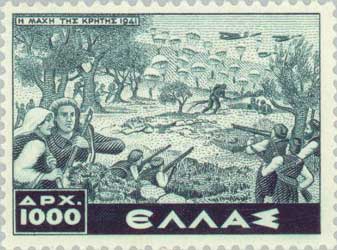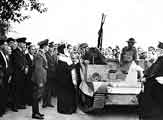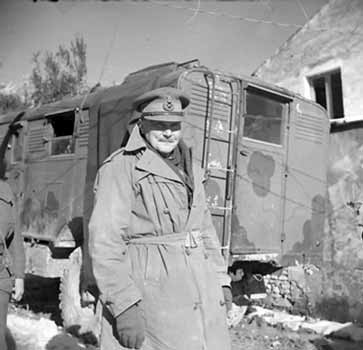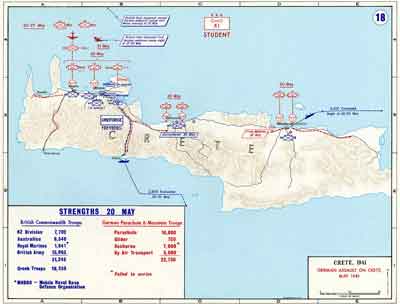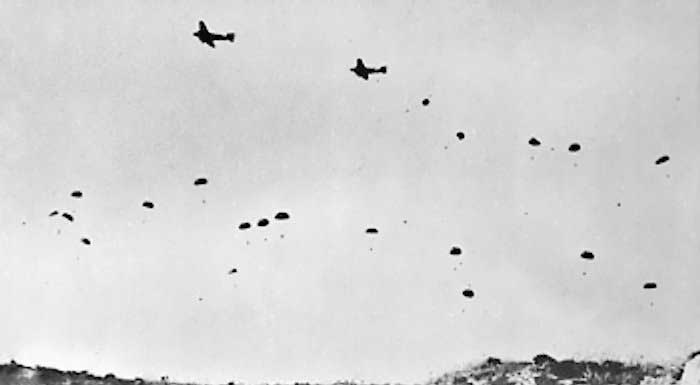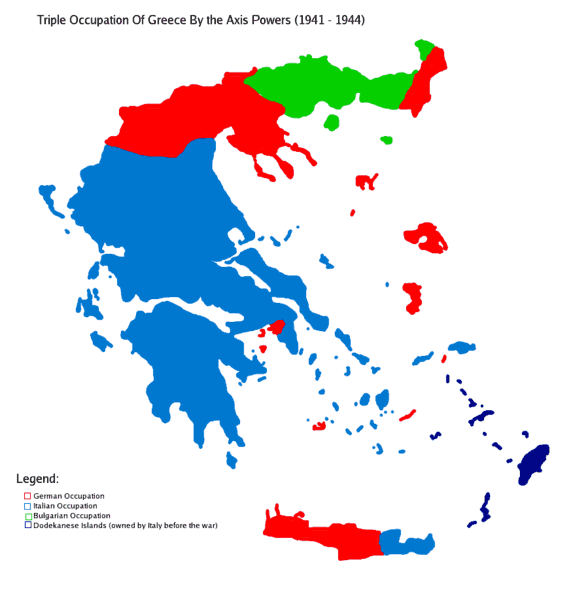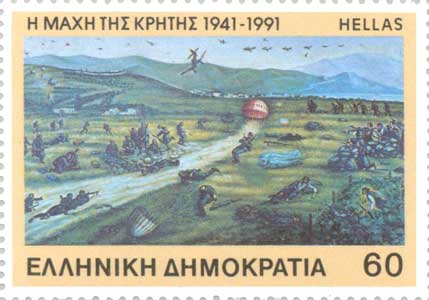The Battle of Crete (German Luftlandeschlacht um Kreta; Greek Μάχη της Κρήτης) began on the morning of 20 May 1941, during World War II, when Germany launched an airborne invasion of Crete under the code-name Unternehmen Merkur (Operation Mercury). The operation was successful in terms of taking the island from the Allied forces holding it, but the victory was so costly that the Germans never again launched a major airborne mission. Today, the Battle of Crete is marked as the first major principally airborne invasion and the largest in history. (The "Market" airborne component of Operation Market Garden was larger, but was backed by advancing armoured units from the beginning). The battle is also especially important to Cretans because of the unexpectedly fierce resistance they put-up against the numerically superior Germans and the terrible toll the invasion and subsequent occupation took on the island's population.
Prelude Allied forces had occupied the island of Crete when the Italians invaded Greece on 28 October 1940. Though the Italians were initially repulsed, the subsequent German intervention drove the 57,000 Allied troops from the mainland. The Royal Navy evacuated many of them, some were taken to Crete to bolster its 14,000-man garrison. Winston Churchill would later write in his The Second World War: To lose Crete because we had not sufficient bulk of forces there would be a crime." In fact, at the outset, the allies had the advantage of numerical superiority and naval supremacy. Their German foe had air supremacy and greater mobility, which allowed them to concentrate their forces more effectively. Allied forces By May 1941, the defence consisted of approximately 9,000 Greeks: three battalions of the 5th (Crete) Division of the Hellenic Army, which had been left behind when the rest of the unit had been transferred to the mainland to oppose the German invasion; the Cretan Gendarmerie (a battalion-sized force); the Heraklion Garrison Battalion, a defence battalion — made up mostly of transport & logistics personnel; and remnants of the 12th and 20th Hellenic Army divisions, which had escaped to Crete and were organised under British command. There were also cadets from the Gendarmerie academy and recruits from the Greek recruit training centres in the Peloponnese, who had been transferred to Crete to replace the trained soldiers being sent to fight on the mainland. These troops were already organized into numbered recruit training regiments, and it was decided to use this existing configuration to organize the Greek troops, supplementing them with experienced men arriving from the mainland. The British and Commonwealth contingent consisted of the original British garrison and another 25,000 Commonwealth troops evacuated from the mainland. The evacuees were the typical mix found in any contested evacuation — there were substantially intact units under their own command, scratch units hurriedly brought together by leaders on the spot, stragglers without leaders from every type of unit possessed by an Army, and deserters. Most of these men lacked heavy equipment. The key formed units were the New Zealand 2nd Division (less the 6th Brigade and division headquarters, which had been sent on to Egypt), the Australian 19th Brigade Group and the British 14th Brigade. Allied armour resources consisted of 16 obsolescent Cruiser Mk I tanks. There were approximately 85 artillery pieces of various calibres — many of them captured Italian pieces without sights.
Bernard Freyberg On 30 April, a New Zealander, Major General Bernard Freyberg was appointed commander of the Allied forces on Crete. Crete in relation to mainland GreecePossession of the island provided the Royal Navy with excellent harbours in the eastern Mediterranean. From Crete, the Ploieşti oilfields in Romania were within bombing range. Also, with Crete in Allied hands, the Axis south-eastern position would never be safe, a vital necessity before starting Operation Barbarossa, (the invasion of Russia). The Germans commenced operations with a constant bombardment of the island which eventually forced the Royal Air Force to remove its planes to Alexandria, giving the Luftwaffe air superiority. However, the island remained a threat and would have to be taken eventually. Axis forces On 25 April, Adolf Hitler signed Directive Number 28, ordering the invasion of Crete. The Royal Navy's forces from Alexandria retained control of the waters around Crete, so any amphibious assault would be quickly decided by the nature of an air-versus-ship battle, making it a risky proposition at best. With German air superiority a given, an airborne invasion was decided on. This was to be the first truly large-scale airborne invasion, although the Germans had used parachute and glider-borne assaults on a much smaller scale in the invasion of France and the Low Countries, Norway and even mainland Greece. In the latter instance, German airborne troops had been dispatched to capture the bridge over the Corinth Canal which was being readied for demolition by the Royal Engineers. German engineers were landed near the bridge in gliders, while parachute infantry attacked the perimeter defence forces. The bridge was damaged in the fighting, which slowed the German advance and gave the Allies time to evacuate 18,000 troops to Crete and an additional 23,000 to Egypt, albeit with the loss of most of their heavy equipment. [1] The intention was to use Fallschirmjäger (Luftwaffe paratroopers) to capture key points of the island, including airfields that could then be used to fly in supplies and reinforcements. The XI Fliegerkorps was to co-ordinate an attack by the 7th Air Division, which would insert its paratroopers by parachute and glider, followed by the 22nd Air Landing Division once the airfields were secure. The assault was initially scheduled for 16 May; it was postponed to 20 May and the 5th Mountain Division replaced the 22nd Division. Strategy, tactics, intelligence, weapons and equipment Intelligence British intelligence & the Ultra intercepts By this time, Allied commanders had become aware of the invasion through Ultra intercepts. General Freyberg was informed of their battle plan, and started to prepare a defence based near the airfields and along the north coast. However, he was seriously hampered by a lack of modern equipment, and was faced with the reality that even the lightly armed paratroopers would be able to manage about the same firepower as his own troops — if not more. German intelligence Admiral Wilhelm Canaris, chief of the German Abwehr, originally reported that there were a mere 5,000 British troops on Crete and no Greek forces. It is not clear whether Canaris, who had an extensive intelligence network at his disposal and was of part-Greek extraction, was misinformed or was attempting to sabotage Hitler's plans (Canaris would later be executed for participating in the July 20 Plot). The Abwehr also predicted that the Cretan population would welcome the Germans as liberators, due to their strong republican and anti-monarchical feelings, and would want to join the "…favourable terms which had been arranged on the mainland…"[2] While it is true that the late republican prime minister of Greece, Eleftherios Venizelos had been a Cretan, and support for his ideas was strong on the island, the Germans seriously underestimated the depth of patriotic feeling on the part of the Cretans. In fact, King George and his entourage escaped from Greece via Crete with the help of Greek and Commonwealth soldiers, Cretan civilians, and even a band of prisoners that had been released from captivity by the advancing Germans. (see below.) German Twelfth Army Intelligence painted a less optimistic picture, but still believed the British & Commonwealth forces to be much fewer than they actually were, and also underestimated the number of Greek troops who had been evacuated from the mainland. General Alexander Löhr, the theatre commander, was convinced that the island could be taken with two divisions, but decided to keep the 6th Mountain Division in Athens as a reserve. Events would prove this to have been a wise precaution. Weapons German The Germans were deploying a new weapon on Crete: the LG40 Panzerabwehrwerfer 7,5, a 75 mm recoilless rifle. At 320 pounds, it weighed only a tenth as much as a standard German 75 mm field gun, yet had two-thirds of its range. The new gun could fling a 13-pound shell over three miles. Adding to the airborne units' firepower was the fact that one-quarter of the German paratroopers jumped with an MP40 submachine gun, often carried in addition to a powerful bolt-action Mauser K98k rifle. Moreover, almost every German squad was equipped with an MG34 light machine gun.[3] The Germans used colour-coded parachutes to distinguish the canisters carrying rifles, ammunition, crew-served weapons and other supplies. Heavy equipment like the LG40 was dropped with a special triple-parachute harness designed to bear the extra weight. The troopers also carried special strips of cloth which could be unfurled in pre-arranged patterns to signal low-flying fighters to coordinate air support and supply drops. A major flaw in Germans airborne procedures was that most of the men's individual weapons were dropped in cannisters; this was in contrast with the practice of most other nations's airborne forces, who routinely jumped with personal weapons strapped to the jumper. While this facilitated exit from the aircraft and prevented loss and damage to the rifles, it left the paratroopers armed only with their sidearms and fighting knives in the critical few minutes after landing. The poor design of German parachutes compunded the problem: the standard German parachute harness had only a single riser connecting the paratrooper to the parachute canopy, and thus could not be steered toward weapons canisters and away from ground hazards during descent. Even the twenty-five percent of paratroops armed with machine pistols were at a distinct disadvantage, given the weapon's limited range. Many Fallschirmjäger were shot attempting to make it to their unit's weapons canisters. Greek Greek troops were armed with the Mannlicher-Schönauer 6.5 mm mountain carbine or with ex-Austrian 8 mm Steyr-Mannlicher M1895 rifles, the latter part of post–World War I reparations. About one thousand of the Greek troops were armed with Gra rifles. The garrison had been stripped of its best crew-served weapons, which were sent to the mainland. There were twelve obscolescent Saint Etienne light machine guns and forty other light machine-guns of various manufacture at the Greek troops' disposal. Many of the Greek troops had less than thirty rounds of ammunition left, and could not be resupplied by the British, who had no stocks in the correct calibers. This affected their placement in the battle; those with insufficient ammunition were posted to the island's eastern sector, where the Germans were not expected in force. The Greeks made up for the lack of equipment with intensity of spirit; historian Christopher Buckley described their fight as one of "…extreme courage and tenacity." (154). British & Commonwealth British and Commonwealth troops used their standard .303 Lee-Enfield rifle and Bren and Vickers machineguns. The Allies on Crete did not possess sufficient Bren gun carrier tankettes or trucks, which would have provided the extra mobility and firepower needed for rapid-response teams to hit paratrooper units before they had a chance to dig in. Anti-aircraft defences consisted of one light AA battery with 20mm automatic cannon, split between the two airfields. The guns were carefully concealed, often in nearby olive groves, and some were ordered to hold their fire during the initial assault so that they would not immediately reveal themselves to German fighters and dive-bombers. The British had nine Matilda IIA "I" tanks belonging to 'B' Squadron, 7th Royal Tank Regiment, and sixteen Mark VIB light tanks from 'C' Squadron, King's Own Hussars. In common with most British tank units at the time, these tanks lacked general purpose high-explosive ammunition for the 2-pdr cannon on the Matildas, possessing only armor piercing rounds which were not effective against infantry.[4] The tanks had numerous maintenance problems. The engines, especially, were worn and could not be overhauled with the limited resources available on Crete. Most of the tanks were therefore used as mobile pillboxes to be brought up and dug in at strategic points. One of the Matildas had a damaged turret crank that allowed it to turn clockwise only. In the end many of the British tanks were lost to the rough terrain, not in combat. Strategy & tactics Operation Mercury There was much debate in the German high command concerning the operational plan for Crete. Though all agreed on the necessity of taking Maleme, there was some debate over the concentration of forces there and the number to be deployed against other targets, such as the smaller airfields at Heraklion and Rethymnon. The Luftwaffe commander, General Alexander Löhr and the naval commander, Counter Admiral Karl-Georg Schuster favored a heavier concentration against Maleme; Major General von Student wanted to disperse his paratroops more widely. Maleme had several advantages: it was the largest airfield, capable of supporting heavy transports bearing reinforcements; it was near enough to the mainland to allow air cover from land-based Bf 109 fighters; and it was near the northern coast, so seaborne reinforcements could be brought up quickly. A compromise plan was forced by Herman Goering and the final plan heavily emphasized securing Maleme first, while not ignoring the other Allied assets. The final plan was codenamed Merkur in German, after the swift Roman god Mercury. German forces were divided into three battle groups, Centre, West and East, each with a special codename following the classical theme established by Mercury. A total of 750 glider troops, 10,000 paratroops, 5,000 airlifted mountain troops, and 7,000 seaborne troops were alloted for the invasion. The largest proportion of the forces were in Group Centre.
For more complete information on the disposition of forces, see Crete order of battle German airborne doctrine was based on parachuting in a small number of forces directly on top of enemy airfields. This force would capture the perimeter and any local anti-aircraft guns, allowing a much larger force to land by glider. Freyberg was aware of this after studying German actions of the past year, and decided to render the airfields unusable for landing. However, he was countermanded by the Middle East Command in Alexandria. They felt the invasion was doomed to fail now that they knew about it, and possibly wanted to keep the airfields intact for the RAF's return once the island was secure, in what is held by some to have been a fatal error. It is not clear whether this is the case, for the Germans proved they were able to land reinforcements without resort to fully-functioning airfields. One German pilot crash-landed his transport on a deserted beach; others landed in empty fields, discharged their cargo and took off again. With the Germans willing to sacrifice some of their numerous transport aircraft to win the battle, it is not clear whether a decision to destroy the airfields would have made any difference to the final outcome. The gliders, were, of course, designed to be expendable and consequently their pilots were even more daring in their landing choices. Day one, May 20 Maleme-Chania sector At 8:00 a.m. on 20 May German paratroopers landed near Maleme and Chania, secondary airfields built to support the island's main airbase at Heraklion. Of the initial forces, the majority were mauled by Allied forces placed near the airfields, in particular many of the gliders following the paratroops were hit by mortar fire within seconds of landing. Those who did land were wiped out almost to a man by the Greek and Commonwealth defenders. Ironically, a number of German forces had landed off-site near both airfields, as is common in airdrops, and set up defensive positions to the west of Maleme airfield, and "Prison Valley" in the Chania area. Although both forces were bottled up and failed to take the airfields, they were in place and the defenders had to deploy to face them. Greek police forces and cadets were also in action, with the First Greek Regiment (Provisional) defeating an incursion by the 95th Gebirgs Pioneer Battalion at Kastelli. Meanwhile, the 8th Greek Regiment and elements of the Cretan forces severely hampered movement by the 95th Reconnaissance Battalion on Kolimbari and Paleochora, where Allied reinforcements from North Africa could potentially be landed. Everywhere on the island, Cretan civilians, armed and otherwise, joined the battle with a savagery unexpected by either side. In one notable incident, an elderly Cretan beat a German parachutist to death with his walking stick. This was not an isolated case, and many Germans met their end by knife or club in the Cretan olive groves and villages. Once they had overcome their shock at such unprecedented resistance from a civilian population, the German paratroopers reacted with equal ferocity. Rethimnon-Heraklion sector
German paratroopers jumping from Ju 52s over Crete. - May 1941 A second German wave arrived in the afternoon, one group attacking Rethimnon at 4:15 p.m. and another at Heraklion at 5:30. As with the earlier actions, the defenders were waiting for them and inflicted heavy casualties. As night fell, none of the German objectives had been secured. The risky plan — attacking at four separate points to fully use surprise rather than concentrating on one — seemed to have failed, although the reasons were unknown to the Germans. Towards the evening of 20 May, the Germans at Maleme were slowly pushing back the New Zealanders from Hill 107, which overlooked the airfield. The commanders on Crete decided to throw everything into the Maleme sector the next day. Among the paratroopers who landed on the first day of the battle was former world heavyweight champion boxer Max Schmeling, who held the rank of Gefreiter (Private First Class) at the time. Schmeling survived the battle and the war. The Escape of the King The majority of Cretans, as mentioned above, were Venizelist Republicans — as were a significant number of mainland Greeks. In 1924, George II, King of the Hellenes had been deposed and exiled to Romania, only to return in 1935 after the collapse of republican government. The Germans regarded George as a hopeless Anglophile and an obstacle to their conquest of Greece, which they believed to be mostly anti-monarchist. After the king escaped to Crete on 22 April and issued a defiant memorandum to the Germans, Hitler responded by attacking the king in a speech given on 4 May. The British feared the propaganda coup that the capture by airborne troops of a sovereign monarch under their protection would represent.[5] The king was staying in a villa near the village of Perivolia, outside Chania. He and his entourage narrowly escaped capture at that house and at the abode of Emmanouil Tsouderos, the prime minister. From the garden of Tsouderos's home, German paratroopers were seen landing in the area of the king's villa, although it later turned out they were members of 3rd Battalion, 3rd Parachute Rifle Regiment, which was assigned to the Galatas sector and whose members had been dropped near the villa by mistake. An evacuation by the Royal Navy had already been arranged, with Col. J.S. Blunt, the British military attaché to Greece acting as liaison. A platoon of New Zealand infantry under Lt. W.H. Ryan was assigned as a bodyguard, along with a complement of Cretan gendarmes. The king was accompanied by his cousin, Prince Peter; Col. M. Levidis, Master of Ceremonies; Prime Minister Tsouderos and Kyriakos Varvaressos, Governor-in-Exile of the Bank of Greece.[6] The party had several close calls with both the Germans and the native Cretans. A detatchment was sent back for some papers left behind by Mr. Tsouderos; they returned to report the house was already occupied, meaning the Germans were by now aware of the king's presence nearby. Lt. Ryan had the king remove his Greek general's uniform, which was adorned with gold braid and other ornaments that were bound to attract attention. At one point the group were pinned down by the rifle fire of Cretan mountaineers. Prince Peter shouted to them in Greek, and they replied "Germans also speak Greek and wear Greek uniforms." Eventually convinced that the royal retinue were not German spies, they let them pass. That night, the evacuees rested in the village of Therisso. There, they were startled by a clamour at the doors, which turned out to be the prison escapees released earlier in the day. Patriotism apparently overwhelmed any sympathy for their German emancipators and antipathy to the monarchist constitution, and the prisoners moved on to forage for weapons instead of betraying their fellow fugitives.[7] Though forced to abandon their pack mules and lacking proper clothing and equipment for mountain climbing, the entourage arrived safely at their rendezvous point. There, joined by evacuating members of the British diplomatic corps, they signalled H.M.S. Decoy and were plucked from the shore, arriving in Alexandria on the night of 22 May. Day two, 21 May The next morning it was found that the New Zealand infantry battalion defending the airfield on Hill 107 had mistakenly withdrawn at night, although they continued to pour artillery fire into the area. This gave the German forces control of the airfield, just as a sea landing took place nearby. That evening Junkers Ju 52 transport aircraft started flying in units of the Fifth Mountain Division. These troops moved into the line as soon as their planes landed, many of which were hit by artillery fire and littered the airfield. Day three, 22 May Realising that Maleme was now the key to holding the entire island, the defending force organised for a counter-attack by two New Zealand battalions on the night of 21–22 May. Fears of a sea landing meant that a number of units that could have taken part in the attack were left in place, although this possibility was removed by a strong Royal Navy presence which arrived too late for the plans to change. The force attacked at night, but by this time the original paratroops had set up defensive lines, and the newly arrived mountain troops proved difficult to dislodge. The attack slowly petered out, failing to retake the airfield. From this point on the defenders were involved in a series of withdrawals to the eastern end of the island, in an attempt to avoid being out-flanked by the oncoming German forces. Withdrawal, 28–31 May Decision in London Command in London eventually decided the cause was hopeless, and ordered a withdrawal from Sphakia. Over the next four nights 16,000 troops were taken off to Egypt by ships including HMS Ajax of Battle of the River Plate fame. A smaller number was withdrawn on a separate mission from Heraklion, but these ships were attacked en route by Luftwaffe dive-bombers and suffered serious losses. The retreat The Anzacs fall back The Germans pushed the British, Commonwealth and Hellenic forces steadily southward, using aerial and artillery bombardment followed by waves of motorcycle and mountain troops (the mountainous terrain made it difficult to employ tanks). The Suda Bay garrisons at Suda and Beritania gradually fell back along the lone road to Vitsilokoumos, just to the north of Sphakia. About halfway there, near the village of Askifou lay a large crater nicknamed "The Saucer." It was the only spot in the rugged terrain sufficiently wide and flat enough to support a large-scale air drop. Troops were stationed about its perimeter to prevent a German airborne force from landing to block the retreat. At the village of Stilos, the 5th New Zealand Brigade and the 2/7th Australian battalion held off a German mountain battalion which had begun a flanking manœuvre, but were forced to withdraw for lack of air and artillery support, despite their superior numbers. Fortunately, German air assets were being concentrated on Rethymnion and Heraklion, and the Anzacs were able to retreat down the road safely in broad daylight. The Māoris make a stand The general retreat of the brigade was covered by two companies of the 28th (Māori) Battalion under Captain Rangi Royal. Royal's men had already distinguished themselves in a ferocious bayonet charge to keep "42nd Street" - a section of road between Suda and Chania - open when it was under threat from troops of the German 141st Mountain Brigade. When the main unit was safely to the rear, the Māoris in turn made their own fighting retreat of twenty-four miles, losing only two killed and eight wounded, all of whom they were able to carry to safety. Thus, the Layforce commando detachment was the only major unit in this area to be cut-off and unable to retreat. The lost detachment Layforce had been sent into Crete via Sphakia when it was stil hoped that large-scale reinforcements could be brought into Crete from Egypt to turn the tide of the battle. The battalion-sized force was split up, with a 200 man detachment under the unit's commander, Robert Laycock, stationed at Suda to cover the retreat of the heavier units. Laycock's men, augmented by three of the remaining British tanks, were joined by the men of the 20th Heavy Anti-Aircraft Battery, who had been assigned to guard the Suda docks and refused to believe that a general evacuation had been ordered. After a day's fierce fighting, Laycock decided to retreat under cover of night to nearby Beritiana. He was joined there by Captain Royal and the Māoris, who took up separate defensive positions and eventually made their fighting retreat. Laycock and his force, however, were cut-off by superior German forces near the village of Babali Khani. Pummeled from the air by dive-bombers, Layforce Detachment was unable to get away. Laycock and his brigade major, novelist Evelyn Waugh were able to escape by crashing through German lines in a tank. Most of the other men of the detachment and their comrades from the 20th were fated to be either killed or captured. Tradition During the evacuation Admiral Cunningham was determined that the "navy must not let the army down." When army generals feared he would lose too many ships, Cunningham said that "It takes three years to build a ship, it takes three centuries to build a tradition." Major Alistair Hamilton, a company commander in the Black Watch, had declared: "The Black Watch leaves Crete when the snow leaves Mount Ida." The major himself never left the island: he was killed by a mortar round, but his men were ordered off, and reluctantly complied. The general consensus among the men was that they were letting their Greek allies down, and while most British heavy equipment was destroyed in order to keep it from falling into enemy hands, the men turned over their ammunition to the Cretans who were staying behind to resist the Germans. Surrender Meanwhile, Colonel Campbell, the commander at Heraklion, was also forced to surrender his contingent. Rethimno fell as well, and on the night of the 30th, German motorcycle troops linked up with Italian troops who had landed that day on the Gulf of Mirabella. The Italian commander in the Dodecanese had volunteered the services of his men as early as 21st May, but the request had to pass through German channels to Hermann Goering, who finally authorized the move when it became clear that the German effort was not moving ahead as quickly as planned. On 1 June the remaining 5,000 defenders at Sphakia surrendered, although many took to the hills and caused the German occupation problems for years. By 1941, an estimated 500 British & Commonwealth troops remained at large, to say nothing of the Greeks, who were more easily able to blend in with the native population. Outcome
Map showning the zones of control of the three occupying powers in Greece during WW2, from 1941 to 1944. Allied commanders were worried about the Germans using Crete as a "springboard" to further operations in the area, possibly a seaborne invasion of Egypt in support of the German/Italian forces operating from Libya. However, these fears were soon put to rest when Operation Barbarossa opened, and it was clear that the German operation was defensive in nature. Losses among the German paratroops meant that the fallschirmjäger were never again used as airborne troops, which eliminated this weapon from use in Russia. Given the poor communications and airbase defences in Russia at the time, this can be considered a very serious setback, as it is likely paratrooper operations would have been highly effective. Ironically, the use of paratroopers in force impressed the Allies. The true high German casualty rate was hidden from Allied planners, who scrambled to create their own large airborne divisions after this battle. A vigorous resistance campaign was instituted almost immediately after the fall of the island and remained active until 1945. This campaign necessitated a garrison of some 50,000 personnel at its peak — troops who could have been used to great effect in other theatres. Casualties
The Germans admitted losses of 6,453 killed, missing and wounded. Today, however, there are around 4,500 German graves at Maleme alone, as all German graves on Crete were transferred to a single place after World War II. Allied soldiers claimed to have buried 900 German corpses in Rethimnon and 1,250 bodies at Heraklion by the fifth day of the battle. German losses may have been considerably higher than admitted. Winston Churchill claimed the Germans must have suffered well over 15,000 casualties, and Admiral Cunningham felt that the figure was more like 22,000. Buckley, based on British intelligence assumptions of two enemies wounded for every one killed, gave a cautious estimate of 16,800 total casualties. Commander Freyberg's fear of an ocean attack and his lack of intelligence on the ground of a major defensive line, became an initial airborn massacre of an estimated 2,000 German paratroopers before they obtained control of airfields.
A trio of brothers, relatives of the Prussian general Gebhard Leberecht von Blücher of Waterloo fame, all perished in the battle. The first to fall was Leberecht von Blücher, who was attempting to resupply his brother, Lieutenant Count Wolfgang von Blücher, with ammunition when the latter and his platoon were surrounded by members of the Black Watch. Leberecht had commandeered a horse which he attempted to gallop through British lines; he almost reached his brother's position, and in fact was shot before the count's very eyes. The next day, the count was killed, followed by the youngest brother, Hans-Joachim, who was reported killed in action a few days later but whose body was never recovered. To this day, Cretan villagers report seeing a ghostly rider galloping at night down a road near the spot where Leberecht was shot; yet until they were told the story of the von Blücher brothers, they had assumed that he was British. The Allies lost 3,500 soldiers: 1,751 dead, with an equal number wounded, and an enormous number captured (12,254 Commonwealth and 5,255 Greek). There were also 1,828 dead and 183 wounded among the Royal Navy. A large number of civilians were killed in the crossfire and died fighting as partisans. Many Cretans were shot by the Germans in reprisals, both during the battle and in the occupation that followed. One Cretan source puts the number of Cretans killed by German action during the war at 6,593 men, 1,113 women and 869 children. The loss of Crete, particularly as a result of the failure of the British land forces to recognise the strategic importance of the airfields, served as a wake-up call for the British Government. As a direct consequence, the RAF was given responsibility for defending its own bases from ground and air attack. The RAF Regiment was formed on 1 February 1942 to meet this requirement, which it does to the present day, and many other services, notably the USAF and RAAF have developed similar organisations. Since the formation of the RAF Regiment, no more RAF airfields were lost to the enemy. Notes
Films
Poster from the Film The 11th day Further reading
Crete Resistance 1941 / 44 Greek Machi Tis Kritis , Chaniotika Nea Retrieved from "http://en.wikipedia.org "
 |
|
|||||||||||||||||||||||||||||||||||||||||||||||||||||||||||||||||||||||||||||||||||||||||||||||||||||||||||||||||||||||||||||||||||||||||||||||||||||||

